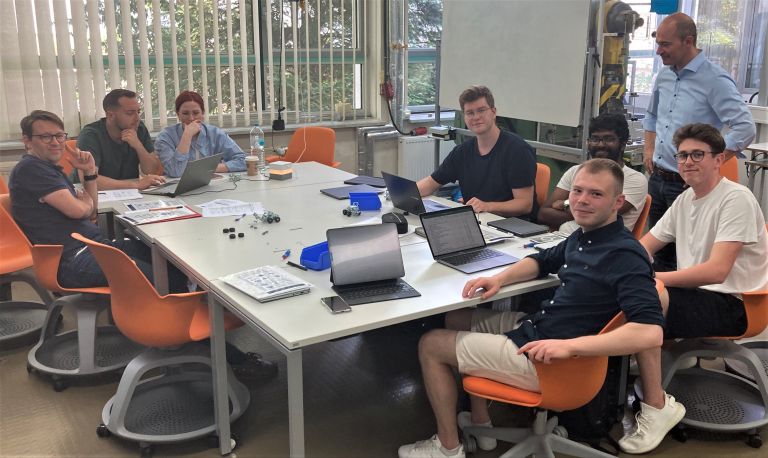
Theorie and practice combined. The students of the industrial engineering bachelor’s degree program at Darmstadt University of Applied Sciences recently had the opportunity to learn about the MTM method standard in detail. They applyed the knowledge in practice right away. “MTM for the digital design of efficient and ergonomic work” was the topic of a guest lecture by Dr. Fabian Nöhring. The Innovation Manager and Project Manager at Deutsche MTM- Gesellschaft mbH gave it as part of the lecture “Production Engineering”.
The MTM expert first gave a brief introduction, addressing the different aspects of MTM: MTM as a method standard of industrial engineering and MTM as an organization. In preparation for the subsequent practical course on the course, he presented, among other things, the basic processes of the MTM-UAS® process building block system. Furthermore, he talked about the measures and potentials for workplace design.
Building bridges with MTMmotion®
Using the example of the MTMmotion® interface solution developed at the MTM Institute and the VR technology used by LivingSolids GmbH, the innovation manager made clear how industrial engineering and new technologies can be linked.
LivingSolids’ software solution uses VR simulation to digitally map workplaces. It thus allows intuitive interaction with 3D models of plant, machinery and technical consumer goods in real time. The data delivered to the MTMmotion® interface are essentially object data, arm movements, body movements as well as body postures. By the way, by looking at the body postures, there is also a potential for ergonomics improvement.
MTMmotion® then converts the digitally captured motion data into MTM analyses. In principle, this process allows ideas to be implemented quickly through virtual trial and error, potentials to be uncovered. The result is an optimal design of workstations.
The presentation was rounded off by practical application examples and a look into the future.
In the practical part, a forklift truck plays the main role
Afterwards, the students were able to apply MTM methods for the design of products and processes themselves in the laboratory of Prof. Dr.-Ing. Marina Dervisopoulos and Prof. Dr.-Ing. The content of the four-hour practical, which has been taking place in this form for several semesters, was assembly planning with MTM-UAS®. The participants had the task to look at the processes and workplaces in the environment of a toy forklift and to design them efficiently.
First, the group dealt with a parts list of the forklift and the tools used for assembly. The creation of a priority graph – a network-like representation of assembly processes – helps to structure the machining and assembly processes. Therefore, it is an important process in assembly planning.
The next step was to analyze the initial state of the product and work system. That gave the students a better understanding of the framework conditions: They may be questioned and, if necessary, adjusted when working out the target state.
Now it was up to the participants to analyze the ACTUAL state with the help of MTM-UAS® and to determine the assembly effort. This is the basis for optimizing the assembly process. The MTM analysis supports the identification of potentials and makes them quantifiable in terms of time – and thus also in monetary terms. Finally, the planning of a TARGET state for a product suitable for assembly as well as an efficient and ergonomic work system was the goal.
The combination of theory and practice in the course “Production Engineering” has proven to be very useful,” says Dr. Fabian Nöhring. He adds that it is a great pleasure to observe the students’ creativity in applying MTM and deriving process optimizations. The good cooperation between the Department of Mechanical and Plastics Engineering at Darmstadt University of Applied Sciences and the Deutsche MTM-Gesellschaft mbH is to be further expanded.
